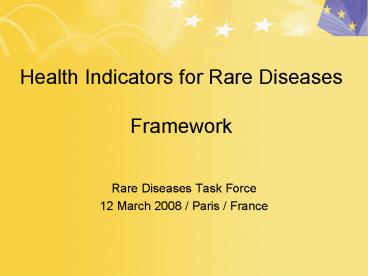Health Indicators for Rare Diseases Framework - PowerPoint PPT Presentation
1 / 21
Title:
Health Indicators for Rare Diseases Framework
Description:
Indicators of special interest to rare diseases include. mortality age, ... Contribution of consanguinity. Availability of appropriate health Services ... – PowerPoint PPT presentation
Number of Views:80
Avg rating:3.0/5.0
Title: Health Indicators for Rare Diseases Framework
1
Health Indicators for Rare DiseasesFramework
- Rare Diseases Task Force
- 12 March 2008 / Paris / France
2
Commission Communication and Health
Indicators for Rare Diseases
3
Problem diagnosis
Indicators of special interest to rare diseases
include mortality age, survival rate from
diagnosis, duration from first symptoms to
diagnosis, related morbidity, and health
expectancies.
4
Indicators to monitor the situation
5
Definition of health indicators
- Parameters used to evaluate
- Health status
- Impact of health policies
- Indicators have to be
- Relevant to the question that is being posed
- Reliable same valu if measures agin
- Useful to decision-makers
- Valid measure what they are meant to measure
- Applicable
- Feasible on a large scale
6
Main objectives of health Indicators
- Measure RD as public health issue
- For visibility / advocacy
- To identify targets of interventions
- To allocate appropriate resources
- Enable surveillance of status and trends
- Measure the impact of prevention / diganosis /
screening / treatment - Identify etiological and modifying factors
- Analyse geographical differences and changes over
time - Document influence of health policy measures
- Guide new research initiatives
- Provide efficient and consistent reporting
mechanisms
7
Legal basis for health indicators
- EC aim is to produce comparable information of
the health status of populations and health
systems - Legal basis
- in the health strategy plan 2008-2013
- Eurostat
- Contract agreement with OECD
- ECHI System of Community Health Indicators
- Project of Communication (2009) in the European
Health Information, Knowledge and eHealth System
8
Past and ongoing projects
- ECHI comprehensive list of 400 indicators with
short list of 80 - ECHIM
- ICHI International Compendium of Health
Indicators - ISARE Health Indicators in the European Regions
- EUPHIX European Public Health Information,
Knowledge and Data management System - EUROTHINE Tackling Health Inequalities in Europe
- EHEMU European Health Expectancy Monitoring Unit
9
Potential sources of data
- Registries
- Death certificates
- Hospital discharge charts
- Surveillance systems
- Patients associations
- Ad Hoc surveys
- Litterature
10
Criteria for selection
- Must be a tool for health policy
- Must be related to a priority health problem
- Must allow comparisons across regions/ over time
- Data should be available
- Must be integrated into a more global perspective
of the health information system
11
Health Indicators for RD
- The classical indicators hardly apply to the
RD area, due to coding difficulties - There is a need to define appropriate goals and
to select potential indicators
12
Health Indicators for Rare DiseasesSelection
process
- Rare Diseases Task Force
- 12 March 2008 / Paris / France
13
Goals
- Document the contribution of RD to morbidity and
mortality - Measure their socio-enconomic impact
- Document the availability of appropriate Health
Services - Document the state of art of RD
- Monitor geographical differences in Europe
- Enable surveillance of status and trends over time
14
Document contribution to morbidity and mortality
- Prevalence (globally and by disease)
- Incidence
- Mortality rate (specific age groups)
- Survival rate
- Health expectancy (DALY, PYLL)
- Contribution to Hospital admissions
- Contribution to mental/physical / neurosensory
disabilities - Contribution to transplantation / dialysis.
- Perceived health (QoL)
- Functional health
15
Measure their socio-enconomic impact
- Impact on families (economic, social,
psychological) - Annual budget to cover orphan drugs
- Contribution of consanguinity
16
Availability of appropriate health Services
- Availability of genetic tests for RD
- by certified laboratories
- by accredited laboratories
- by laboratories participating in EQA schemes
- Number of diseases for which there is a
biological test - Number of diseases for which neonatal screening
is in place - Impact of prenatal diagnosis on birth prevalence
- Identified expert clinics
17
Availability of appropriate health Services
- Age at diagnosis
- Proportion of patients at home or in institutions
- Availability of orphan drugs among those with
EMEA approval - Number of Patients organizations and of diseases
cove - Availability of Help-lines for RD
18
Information, research, technology development
- Number of RD with a specific code in ICD
- New Orphan products approved by the EMEA
- Call for proposals for research into RD
- RD for which good practice guidelines are
available - RD for which there is a registry, geographical
coverage - RD for which there are on-going clinical trials
19
Equity, regional differences EU initiatives
- Countries with specific funding processes and
Plans for RD - In the field of research
- In the field of information
- In the field of clinical care
- Centres of expertise
- Orphan drugs
- In the field of testing
- European reference networks for RD
- European registries
- EU Funding programs for research and public
health in RD - Courses, congresses and seminars in RD
20
Surveillance of status and trends
- RD for which a diagnostic test exists (genetic,
biochemical, other) - Laboratories accredited for genetic testing
- Neonatal screenings
- Prenatal diagnosis
- Diagnosis delay
- Perceived health (QoL)
- People at home or in institutions
- New Orphan products approved by EMEA
- of marketed drugs among those with EMEA approval
21
Next step
- To be defined together
- What should be done
- Who should dot it
- How it should be done
- What are the available resources






























